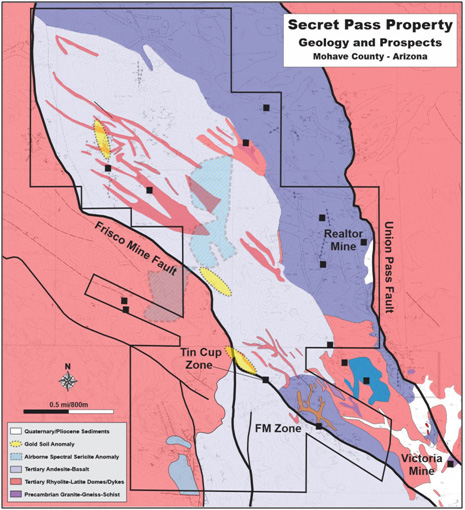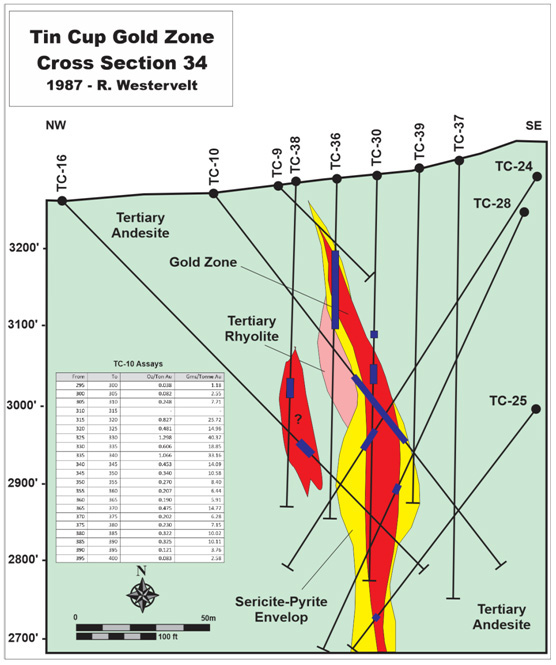Projects
Secret Pass Gold Project
Geology, Previous Production and Exploration on Tin Cup & FM Zone Prospects
Historic Production and Exploration
The Secret Pass Gold Project is situated within a structurally complex region characterized by an imbricated system of shallow to steeply dipping faults trending north-northwest. As depicted in Figure 2, this fault system extends approximately 65 km, linking the Oatman District in the south, the Secret Pass-Frisco Mine area, and the Katherine Gold District to the north.
Regional Structures and Gold Showings
Two significant regional structures, the Union Pass Fault and the Frisco Mine Fault, traverse the Secret Pass property (Figure 3). These faults are associated with numerous gold showings and historic mining prospects, some of which have reported limited gold production. The Oatman District, located approximately 13 km south of the Secret Pass property, has historically produced over two million ounces of gold.
Mining records document 15 historic mine workings within the Secret Pass license area. The Tin Cup and FM gold prospects were intensively explored and drilled by Santa Fe Mining and Fischer-Watt between 1984 and 1991. A total of 14,000 metres of drilling was completed across 126 drill holes, including 114 reverse circulation and 12 core holes.

Figure 3: Secret Pass Project Geology and Historic Mine Workings
Tin Cup Gold Zone
The Tin Cup Gold Zone is localized along the steeply northeast-dipping Frisco Mine Fault. Gold mineralization occurs within Tertiary andesite and is associated with the margins of rhyolite dykes forming lenses within the fault structure. Deeper drill holes have intersected gold mineralization within Proterozoic basement granite.
The mineralized zone has a strike length of approximately 245 metres and a drill-indicated depth of up to 180 metres, with both dimensions open along strike and at depth. High-grade gold mineralization (>3 g/t Au) is concentrated in a 3.0 to 7.6-metre-wide steeply dipping structure within a broader mineralized fault zone measuring 30 to 45 metres in width. The mineralization exhibits a northwest plunge and remains open at depth. Surface oxidation extends to approximately 120 metres.
FM Gold Zone
The FM Gold Zone is also controlled by the northwest-trending Frisco Mine Fault, which dips steeply to the southwest. Gold mineralization at this zone is hosted exclusively within granite and rhyolite, with a strike length of approximately 200 metres and a drill-indicated depth of up to 120 metres, open along strike and depth.
At the surface, the mineralized zone varies from 13 to 30 metres in width, transitioning at depth into distinct near-vertical structures ranging from 3.0 to 8.0 metres in width with lower-grade mineralization (<1.5 g/t Au). Oxidation depths are variable but generally extend to between 75 and 100 metres.
Geological Models of Gold Mineralization
Two geological models have been proposed for gold mineralization at Secret Pass:
- Epithermal Bonanza-Style Veining and Stockwork – Gold mineralization results from repeated boiling events within vein systems and hanging wall stockworks. This model is prevalent in the Oatman Gold District.
- Low-Angle Detachment Fault Model – Gold deposition occurs at an oxidation-reduction boundary along a low-angle detachment fault. This model is similar to mineralization in the Katherine Gold District, located approximately 15 km northwest of the Secret Pass property.
Tin Cup Mine – Historic Production and Drilling Results
The Tin Cup Mine reportedly produced several hundred tons of mineralized material grading between 15 g/t (0.5 oz/t) and 31 g/t (1 oz/t) gold. Mining operations during the 1930s included an open pit and an inclined shaft reaching a depth of 21 metres (70 feet), with limited underground workings. No known production has occurred since the 1930s.
During the 1984-1991 drilling campaign, multiple significant gold intercepts were recorded within the Tin Cup Gold Zone. As illustrated (Figure 4), historical gold assays returned values as high as 40 g/t Au over considerable widths, at depths ranging from 30 to 180 metres below the surface. These results are historical in nature, and a qualified person has not conducted sufficient work to verify the reported drilling intersections.
The Secret Pass Gold Project remains a highly prospective area for further exploration and development, with multiple mineralized zones remaining open at depth and along strike.

Figure 4: Historical Cross Section of Tin Cup Gold Zone
(Modified from Arrowstar Resources NI 43 - 101 Report, May 4, 2016. Note this information is historical and has not been verified by a qualified person under the guidelines of NI 43-101)
